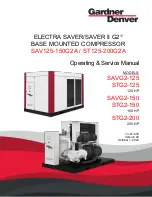
8
Trouble Shooting the System
Quick accurate diagnosis of problems will help to effect repairs in a timely fashion and should involve the
following:
a) Understand the operational characteristics of the system to better determine the problem.
b) Run the system, if possible, to determine the problem.
c) Do not perform test procedures that are harmful to people or equipment.
d) Perform repairs using the correct parts and procedures.
e) Consult your local dealer or Airworks Compressors Corp.
Symptom:
Compressor does not produce adequate air
Check and correct the following:
a) Compressor oil level is correct
b) Coupling between engine and compressor is intact
c) Pressure switch is operational
d) Air filters are clean
e) Engine RPM is set to spec, adjust as required
f) Blockage downstream of compressor
g) No air produced - minimum pressure valve sticking or misadjusted.
Symptom:
Frequent over-temperature shut downs
Check and correct the following:
a) Check engine and compressor oil levels
b) Check engine coolant level, while unit is cool
c) Check engine and compressor hoses for kinks
d) Check engine and compressor over temp shut down temp probes
e) Check for adequate air circulation around unit, hot air shall not be drawn into unit.
f) Check oil filters not plugged
g) Fan belt is properly adjusted
h) Radiator core dirty/blocked, clean with caution using compressed air. Do not damage fins.
i)
Faulty over temp switch on engine (240°F) or compressor (270°F)
Symptom:
Excessive air pressure
Check and correct the following:
a) Check pressure switch for correct operation
b) System pressure line leaking (from compression to pressure switch)
c) Inlet valve functioning and power to solenoid valve











































